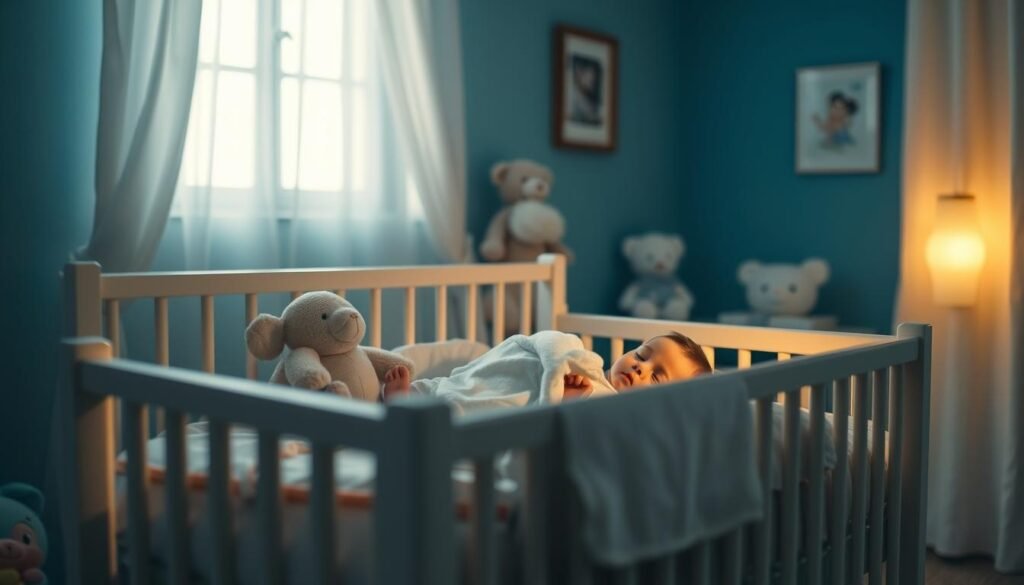Did you know about 70% of kids might wake up at night feeling scared because they miss their parents? This happens mainly to babies from 6 months to 2 years old. It’s a big change for them as they begin to realize even when they can’t see someone, that person still exists. This is called object permanence. It leads to what we know as baby separation anxiety signs. Nighttime can be tough, with more tears, neediness, and crankiness. It’s really important for moms and dads to spot these signs early.
Once parents get what’s going on, they can make things better. They can create calm bedtime habits and teach their kids it’s okay to be apart for a little while. This will help little ones feel safe at night. They’ll start to handle being away from their parents better.
Key Takeaways
- Separation anxiety typically peaks between 9 and 18 months of age.
- Common signs include crying, clinginess, and disruptions during sleep.
- Consistent bedtime routines provide a sense of security for infants.
- Transitional objects, like loveys, can ease anxiety in 70% of children.
- Gradual separation practices help build comfort with temporary absences.
- Positive reinforcement fosters secure attachment and reduces anxiety.
What is Separation Anxiety in Babies?
Separation anxiety is a typical stage in baby growth. It shows up when babies understand that being apart from their caregivers is not permanent. This emotional phase is most intense between 10 and 18 months. Around 70% of babies show signs of it. Knowing about this anxiety is important because it shows that babies are forming strong bonds. It helps them understand that their loved ones still exist, even when they can’t see them.
Signs can appear as soon as 6 months old. Babies become more clingy and cry more when their parent leaves. Hunger, tiredness, or sickness can make these separation anxiety symptoms in infants worse. As kids get near 3 years old, they might go through a similar phase again. This anxiety often affects sleep, with 30-40% of kids crying at bedtime or waking up a lot.
Researchers say that comfort objects can really help with separation anxiety. They help during big changes. With these methods, babies feel safe to explore around. They know their caregivers will come back soon.
For more tips on understanding infant separation anxiety, look at how short separations and quick goodbyes can help. This makes things easier for both the child and the caregiver.
Understanding Infant Separation Anxiety
It’s key for parents to understand infant separation anxiety as it’s a normal part of growing up. This happens when babies begin to recognize people they know and form strong bonds. Around the age of 6-12 months, a baby might become clingy or cry when their main caregiver leaves. This shows their need for someone they trust to feel safe and comforted. Knowing how to deal with separation anxiety helps both kids and parents.
Why Does Separation Anxiety Occur?
There are many reasons why babies feel separation anxiety. They might react strongly to new places or people they don’t know, especially as they start to move around more. By the time they are about 6 months old, they might start feeling anxious when they are not with their caregiver. This can get stronger between the ages of 8 and 10 months. This is also when they begin to understand object permanence, realizing things still exist, even if they can’t see them. Around two-thirds of all children experience separation anxiety during this time.
When kids get a bit older, towards toddlerhood, they might feel anxious again. This happens around 14-18 months old. They may get more clingy or wake up a lot during the night. This affects about 20-30% of toddlers who are 2 years old. Parents can help by being soothing and having a regular bedtime routine. Trying out planned short separations can also teach them how to deal with being apart in a better way.
Using tools like the Pampers Smart Sleep Coach app can help spot when a child is feeling anxious. This app offers tips and support for sleep issues. It’s a useful way for parents to understand and support their child’s emotional needs during important growth stages.

Common Signs of Separation Anxiety in Babies at Night
Babies show signs of separation anxiety at night in different ways. A baby might cry a lot when their caregiver leaves. Or, they might have trouble going to sleep. This can lead to them waking up a lot, which disturbs everyone’s sleep.
A baby might also get clingy or fussy at bedtime, especially if things change. If a usually calm baby starts waking up crying without a parent close, they might be feeling anxious about being apart. It’s important to know that about 70% of babies go through this between 8 to 10 months old.
To ease these worries, set a regular bedtime routine and start short separations. Using something familiar for comfort helps a lot. If parents stay calm and caring when they leave, it teaches the baby they are safe. This makes dealing with separation anxiety easier at night. For tips on how to make this better, visit this resource.